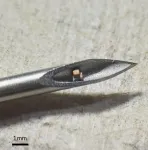(Press-News.org) New York, NY--May 11, 2021--Widely used to monitor and map biological signals, to support and enhance physiological functions, and to treat diseases, implantable medical devices are transforming healthcare and improving the quality of life for millions of people. Researchers are increasingly interested in designing wireless, miniaturized implantable medical devices for in vivo and in situ physiological monitoring. These devices could be used to monitor physiological conditions, such as temperature, blood pressure, glucose, and respiration for both diagnostic and therapeutic procedures.
To date, conventional implanted electronics have been highly volume-inefficient--they generally require multiple chips, packaging, wires, and external transducers, and batteries are often needed for energy storage. A constant trend in electronics has been tighter integration of electronic components, often moving more and more functions onto the integrated circuit itself.
Researchers at Columbia Engineering report that they have built what they say is the world's smallest single-chip system, consuming a total volume of less than 0.1 mm3. The system is as small as a dust mite and visible only under a microscope. In order to achieve this, the team used ultrasound to both power and communicate with the device wirelessly. The study was published online May 7 in Science Advances.
"We wanted to see how far we could push the limits on how small a functioning chip we could make," said the study's leader Ken Shepard, Lau Family professor of electrical engineering and professor of biomedical engineering. "This is a new idea of 'chip as system'--this is a chip that alone, with nothing else, is a complete functioning electronic system. This should be revolutionary for developing wireless, miniaturized implantable medical devices that can sense different things, be used in clinical applications, and eventually approved for human use."
The team also included Elisa Konofagou, Robert and Margaret Hariri Professor of Biomedical engineering and professor of radiology, as well as Stephen A. Lee, PhD student in the Konofagou lab who assisted in the animal studies.
The design was done by doctoral student Chen Shi, who is the first author of the study. Shi's design is unique in its volumetric efficiency, the amount of function that is contained in a given amount of volume. Traditional RF communications links are not possible for a device this small because the wavelength of the electromagnetic wave is too large relative to the size of the device. Because the wavelengths for ultrasound are much smaller at a given frequency because the speed of sound is so much less than the speed of light, the team used ultrasound to both power and communicate with the device wirelessly. They fabricated the "antenna" for communicating and powering with ultrasound directly on top of the chip.
The chip, which is the entire implantable/injectable mote with no additional packaging, was fabricated at the Taiwan Semiconductor Manufacturing Company with additional process modifications performed in the Columbia Nano Initiative cleanroom and the City University of New York Advanced Science Research Center (ASRC) Nanofabrication Facility.
Shepard commented, "This is a nice example of 'more than Moore' technology--we introduced new materials onto standard complementary metal-oxide-semiconductor to provide new function. In this case, we added piezoelectric materials directly onto the integrated circuit to transducer acoustic energy to electrical energy."
Konofagou added, "Ultrasound is continuing to grow in clinical importance as new tools and techniques become available. This work continues this trend."
The team's goal is to develop chips that can be injected into the body with a hypodermic needle and then communicate back out of the body using ultrasound, providing information about something they measure locally. The current devices measure body temperature, but there are many more possibilities the team is working on.
INFORMATION:
About the Study
The study is titled "Application of a sub-0.1-mm3 implantable mote for in vivo real-time wireless temperature sensing."
Authors are: Chen Shi1, Victoria Andino-Pavlovsky1, Stephen A. Lee2, Tiago Costa1,3, Jeffrey Elloian1, Elisa E. Konofagou2,4, Kenneth L. Shepard1,2
1 Department of Electrical Engineering, Columbia University
2Department of Biomedical Engineering, Columbia University
3Department of Microelectronics, Delft University of Technology, The Netherlands
4Department of Radiology, Columbia University
The study was supported in part by a grant from the W. M. Keck Foundation and by the Defense Advanced Research Projects Agency (DARPA) under Contract HR0011-15-2-0054 and Cooperative Agreement D20AC00004.
Chen Shi and Kenneth L. Shepard are listed as inventors on a provisional patent filed by Columbia University (Patent Application No. 15/911,973). The other authors declare
no competing interests.
LINKS:
Paper: https://advances.sciencemag.org/content/7/19/eabf6312
DOI: 10.1126/sciadv.abf6312
http://engineering.columbia.edu/
http://advances.sciencemag.org/
https://engineering.columbia.edu/faculty/ken-shepard
http://www.ee.columbia.edu/
http://bme.columbia.edu/
http://cni.columbia.edu/cni
Columbia Engineering
Columbia Engineering, based in New York City, is one of the top engineering schools in the U.S. and one of the oldest in the nation. Also known as The Fu Foundation School of Engineering and Applied Science, the School expands knowledge and advances technology through the pioneering research of its more than 220 faculty, while educating undergraduate and graduate students in a collaborative environment to become leaders informed by a firm foundation in engineering. The School's faculty are at the center of the University's cross-disciplinary research, contributing to the Data Science Institute, Earth Institute, Zuckerman Mind Brain Behavior Institute, Precision Medicine Initiative, and the Columbia Nano Initiative. Guided by its strategic vision, "Columbia Engineering for Humanity," the School aims to translate ideas into innovations that foster a sustainable, healthy, secure, connected, and creative humanity.
2003 was a big year for virologists. The first giant virus was discovered in this year, which shook the virology scene, revising what was thought to be an established understanding of this elusive group and expanding the virus world from simple, small agents to forms that are as complex as some bacteria. Because of their link to disease and the difficulties in defining them--they are biological entities but do not fit comfortably in the existing tree of life--viruses incite the curiosity of many people.
Scientists have long been interested in how viruses evolved, especially when it comes to giant viruses that can produce new viruses with very little help from the host--in contrast to most small viruses, which utilize the host's machinery to replicate. ...
Surgical cesarean births can expose new mothers to a range of health complications, including infection, blood clots and hemorrhage. As part of Healthy People 2020 and other maternal health objectives, the state of California exerted pressure to reduce cesarean deliveries, and statewide organizations established quality initiatives in partnership with those goals. In this study, researchers from Stanford University and the University of Chicago examined unit culture and provider mix differences on hospital and delivery units to identify characteristics of units that successfully reduced their cesarean delivery rates. The mixed-methods study surveyed ...
From the branching pattern of leaf veins to the variety of interconnected pathways that spread the coronavirus, nature thrives on networks -- grids that link the different components of complex systems. Networks underlie such real-life problems as determining the most efficient route for a trucking company to deliver life-saving drugs and calculating the smallest number of mutations required to transform one string of DNA into another.
Instead of relying on software to tackle these computationally intensive puzzles, researchers at the National Institute of Standards and Technology ...
Most patients with depression are treated in primary care, however, relatively few clinical trials for treating depression have focused on primary care. Researchers at the Vrije University Amsterdam examined the effects of the two major approaches to treating depression: psychotherapy and pharmacotherapy, as well as combined treatment and care-as-usual. The study integrated the results of 58 randomized controlled trials with a total of 9,301 patients. Results concluded that both psychotherapy and pharmacotherapy were significantly more effective than care-as-usual or waitlist control. However, they found no significant difference between psychotherapy and pharmacotherapy as stand-alone treatments. Combined treatment, particularly in studies that included ...
It's widely understood that people taking a common class of antibiotics, like ciprofloxacin and levofloxacin, run the risk of tendonitis and tendon ruptures. However, a new analysis sheds light on newer, third-generation fluoroquinolones and suggests they may have a lower risk of Achilles tendon rupture. Researchers from Jichi Medical University in Tochigi, Japan, used health care administrative data to identify 504 patient cases of Achilles tendon ruptures with co-occurrence of antibiotics. They found that third-generation fluoroquinolones were not associated with an increase in Achilles tendon rupture. First- ...
DURHAM, N.C. -- You enter a room and quickly scan the crowd to gain a sense of who's there - how many men versus women. How reliable is your estimate?
Not very, according to new research from Duke University.
In an experimental study, researchers found that participants consistently erred in estimating the proportion of men and women in a group. And participants erred in a particular way: They overestimated whichever group was in the minority.
"Our attention is drawn to outliers," said Mel W. Khaw, a postdoctoral research associate at Duke and the study's lead author. "We tend to overestimate people who stand out in a crowd."
For the study, which appears ...
Researchers from the Cleveland Clinic and Takeda Pharmaceutical Company conducted a study to evaluate the effectiveness of shared medical appointments for people with pre-diabetes compared with a group of patients receiving usual care. Shared medical appointments are typically delivered in a medical clinic by physicians and other health care providers. Within the context of this study, shared medical appointments consisted of patients consulting with their doctors one-on-one and then joining a group of similar patients to set goals and review lab results with the same family ...
Between 11% to 40% of adults in the United States experience chronic pain, and primary care physicians may feel ill-equipped to effectively and safely care for patients with chronic pain, addiction or both. Researchers from Tufts University conducted a study to evaluate the effectiveness of an interdisciplinary consultation service that supports primary care physicians who care for patients experiencing chronic pain and addiction. The goal was to identify new and effective strategies that clinics can use to support PCPs.
From that interdisciplinary consultation service, the researchers collected ...
Bacteria that move around live on the edge. All the time. Their success, be it in finding nutrients, fending off predators or multiplying depends on how efficiently they navigate through their confining microscopic habitats. Whether these habitats are in animal or plant tissues, in waste, or in other materials. In a recent paper published in PNAS, a team of researchers led by McGill University, has described a number of factors affecting how five, very different, species of bacteria search and navigate through varied microfluidic environments which pose various decisional challenges. This increased understanding of the bacterial space searching and navigational 'strategies' has implications ...
Antibiotics: Patient Expectations and Doctors' Prescribing Habits May Contribute to Antimicrobial Resistance
Inappropriate antibiotic prescribing for upper respiratory tract infections contributes to antibiotic resistance, making some bacterial infections difficult to treat. This often leads to higher medical costs, prolonged hospital stays and increased mortality. Still, many physicians report prescribing antibiotics at their patients' request. To address patients' expectations for antibiotic prescribing for URTIs, researchers conducted an experiment in which study participants were assigned brief educational videos to watch on a tablet immediately prior to their appointment.
The authors randomized patients into three groups - one that viewed a presentation about ...




